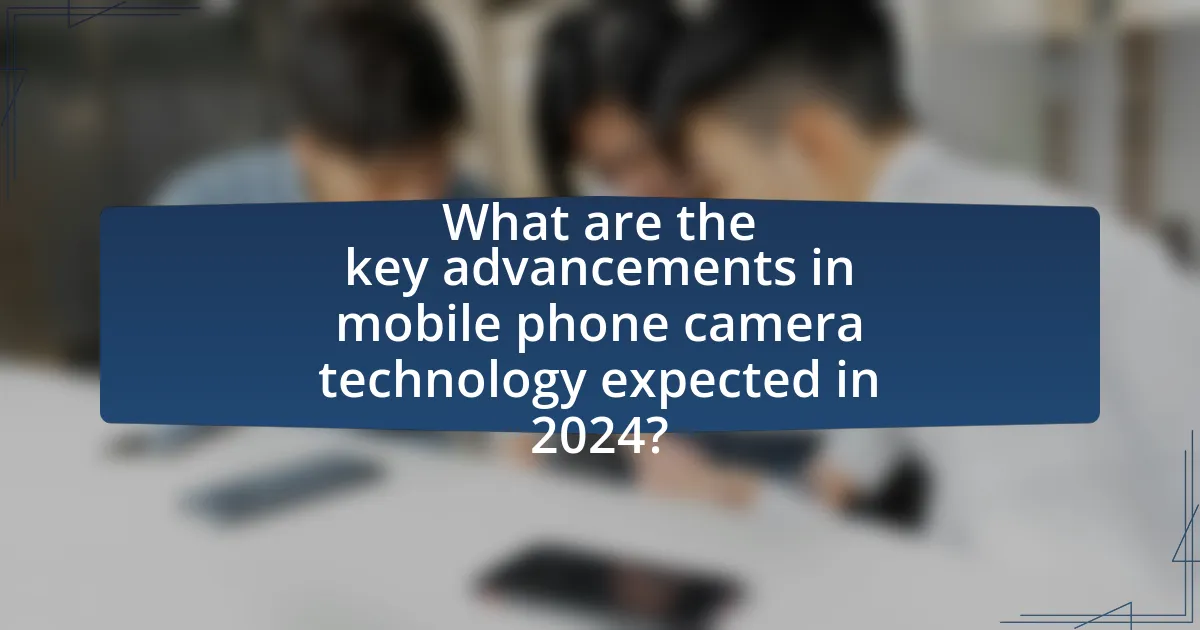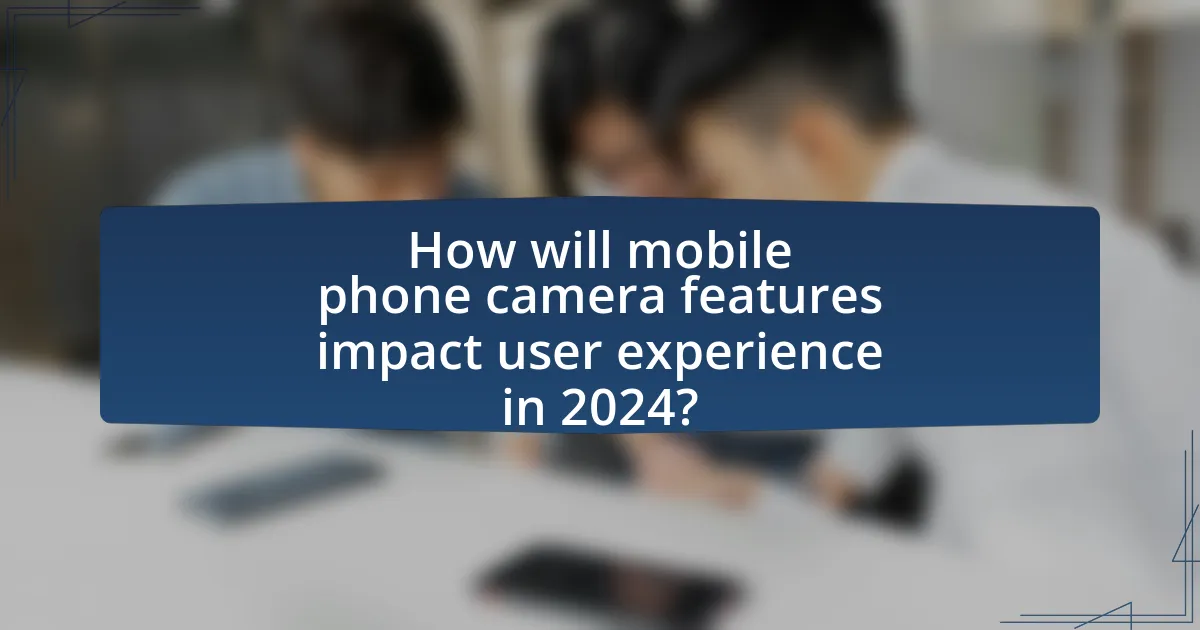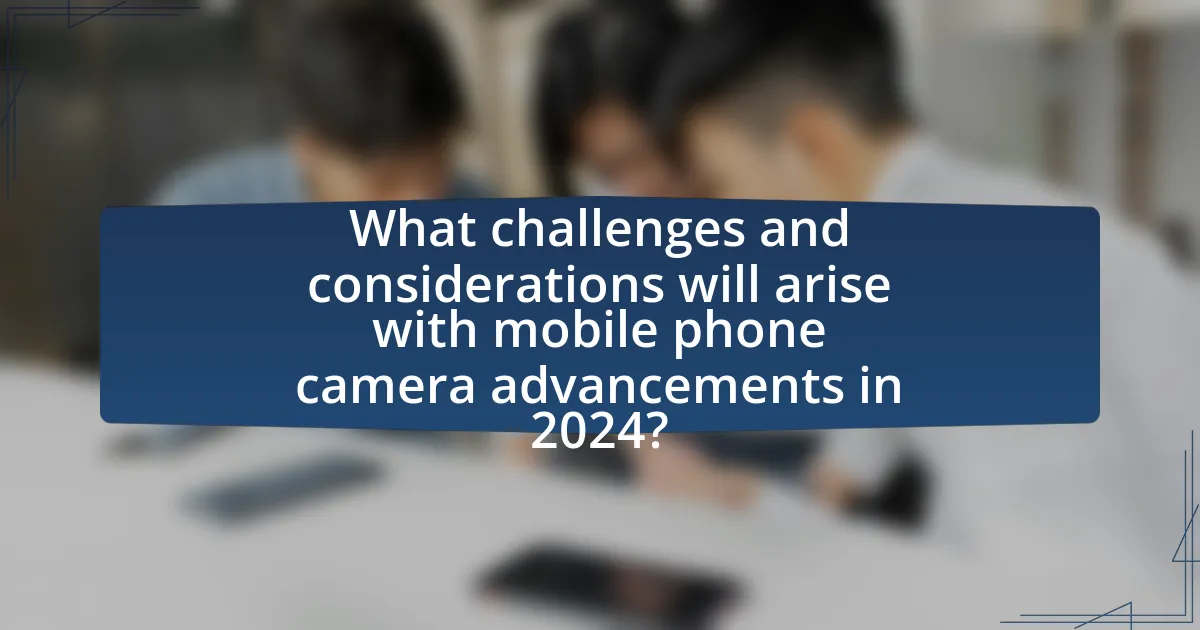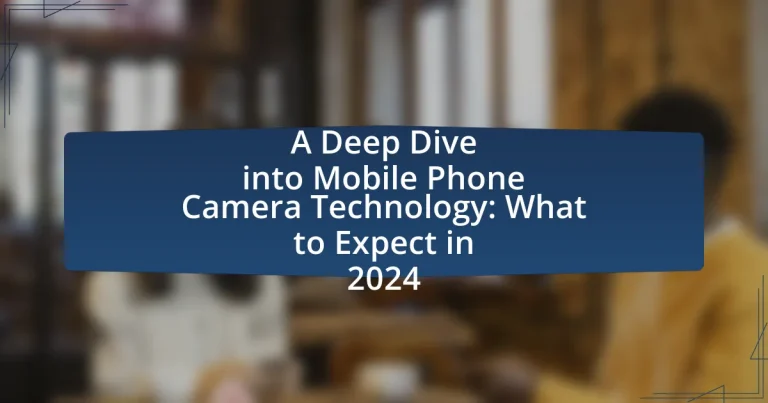The article focuses on the anticipated advancements in mobile phone camera technology for 2024, highlighting key developments such as enhanced computational photography, improved low-light performance, and AI-driven features. It explores the evolution of sensor technologies, including larger sensors and stacked designs that enhance image quality and performance. The integration of AI in mobile photography is discussed, emphasizing its role in automating image processing and improving user experience. Additionally, the article examines innovations in lens technology, multi-lens systems, and the implications of these advancements on social media and content creation, while also addressing potential challenges such as privacy concerns and increased complexity.

What are the key advancements in mobile phone camera technology expected in 2024?
Key advancements in mobile phone camera technology expected in 2024 include enhanced computational photography, improved low-light performance, and the integration of AI-driven features. Enhanced computational photography will leverage advanced algorithms to optimize image processing, resulting in higher-quality photos with better dynamic range and detail. Improved low-light performance is anticipated due to larger sensor sizes and better image stabilization technologies, allowing users to capture clearer images in challenging lighting conditions. Additionally, AI-driven features will enable smarter scene recognition and automatic adjustments, making photography more intuitive and accessible for users. These advancements are supported by ongoing research and development in sensor technology and machine learning applications in imaging.
How are sensor technologies evolving in mobile cameras?
Sensor technologies in mobile cameras are evolving through advancements in pixel size, sensor architecture, and computational photography. Recent developments include the introduction of larger sensors that capture more light, enhancing low-light performance and dynamic range. For instance, Sony’s IMX989 sensor, with a 1-inch format, significantly improves image quality by allowing for larger individual pixels, which can gather more light compared to smaller sensors. Additionally, innovations like stacked sensor designs enable faster readout speeds and improved autofocus capabilities, as seen in Samsung’s ISOCELL technology. These advancements are supported by the integration of AI algorithms that optimize image processing, further enhancing the overall photographic experience in mobile devices.
What types of sensors are being developed for mobile phones?
Various types of sensors are being developed for mobile phones, including advanced image sensors, LiDAR sensors, and environmental sensors. Advanced image sensors, such as those utilizing stacked CMOS technology, enhance low-light performance and dynamic range, enabling better photography in diverse conditions. LiDAR sensors improve depth perception and augmented reality experiences by accurately measuring distances. Environmental sensors, including air quality and temperature sensors, are being integrated to provide users with real-time data about their surroundings. These developments reflect ongoing trends in enhancing mobile phone capabilities, particularly in photography and user interaction.
How do these sensors improve image quality and performance?
These sensors enhance image quality and performance by capturing more light and detail, which results in clearer and more vibrant images. Advanced sensor technologies, such as larger pixel sizes and improved dynamic range, allow for better low-light performance and reduced noise in images. For instance, sensors with back-illuminated designs can increase light sensitivity, leading to improved image clarity in challenging lighting conditions. Additionally, features like phase detection autofocus and faster readout speeds contribute to quicker focus and reduced motion blur, further enhancing overall image quality.
What role does artificial intelligence play in mobile photography?
Artificial intelligence significantly enhances mobile photography by automating image processing and improving photo quality. AI algorithms analyze scenes in real-time, optimizing settings such as exposure, white balance, and focus to produce clearer and more vibrant images. For instance, AI-driven features like scene recognition can identify subjects and adjust camera parameters accordingly, resulting in better portraits or landscapes. Additionally, AI enables advanced functionalities such as portrait mode, night mode, and image stabilization, which contribute to professional-grade photography on mobile devices. According to a report by IDC, 80% of smartphone users consider camera quality a crucial factor in their purchasing decisions, highlighting the importance of AI in meeting consumer expectations for high-quality mobile photography.
How is AI enhancing image processing in mobile cameras?
AI enhances image processing in mobile cameras by enabling advanced features such as scene recognition, noise reduction, and image stabilization. These capabilities allow cameras to automatically adjust settings based on the environment, improving photo quality in various lighting conditions. For instance, AI algorithms can analyze a scene and optimize exposure, contrast, and color balance, resulting in more vibrant and accurate images. Additionally, AI-driven noise reduction techniques significantly enhance low-light photography by minimizing graininess, while computational photography methods, such as HDR and portrait mode, leverage AI to create depth effects and dynamic range improvements. These advancements are supported by the integration of machine learning models that continuously learn from user interactions and image data, further refining the camera’s performance over time.
What are the implications of AI for user experience in photography?
AI significantly enhances user experience in photography by automating complex tasks, improving image quality, and personalizing user interactions. For instance, AI algorithms can automatically adjust settings such as exposure and focus, allowing users to capture high-quality images without extensive technical knowledge. Additionally, features like scene recognition and object detection enable smartphones to optimize camera settings based on the environment, resulting in better photographs. Research from the International Journal of Computer Vision highlights that AI-driven enhancements can lead to a 30% increase in user satisfaction due to improved image outcomes. Furthermore, AI can analyze user preferences over time, offering tailored suggestions for editing and shooting styles, thereby creating a more engaging and intuitive photography experience.
What innovations in lens technology can we expect?
Innovations in lens technology expected in 2024 include advancements in multi-element lens designs, improved optical coatings, and the integration of artificial intelligence for enhanced image processing. Multi-element lens designs will allow for better light transmission and reduced distortion, as seen in recent smartphone models that utilize complex lens arrangements to achieve higher image quality. Improved optical coatings will minimize glare and enhance color accuracy, which is crucial for capturing vibrant images in various lighting conditions. Additionally, the integration of AI will enable real-time adjustments to lens settings, optimizing focus and exposure based on scene analysis, thereby improving overall photographic outcomes. These innovations are driven by ongoing research and development in optical engineering and consumer demand for higher-quality mobile photography.
How are multi-lens systems changing mobile photography?
Multi-lens systems are transforming mobile photography by enabling diverse photographic capabilities and enhancing image quality. These systems allow smartphones to incorporate multiple lenses, such as wide-angle, telephoto, and macro, which provide users with greater versatility in capturing different types of scenes. For instance, the integration of a telephoto lens allows for high-quality zoom without loss of detail, while a wide-angle lens captures expansive landscapes. According to a report by Counterpoint Research, smartphones with multi-lens setups have seen a significant increase in market share, indicating consumer preference for enhanced photographic features. This shift not only improves user experience but also pushes manufacturers to innovate further, leading to advancements in computational photography techniques that optimize image processing across various lenses.
What advancements are being made in optical zoom capabilities?
Advancements in optical zoom capabilities include the development of periscope lenses and improved lens materials, allowing for higher magnification without sacrificing image quality. For instance, smartphones like the Samsung Galaxy S21 Ultra feature a 10x optical zoom using a periscope design, which utilizes a series of lenses to bend light and achieve greater zoom levels. Additionally, advancements in computational photography enhance optical zoom by combining multiple images to improve clarity and detail at high zoom levels, as seen in devices like the Google Pixel series. These innovations demonstrate a significant leap in mobile camera technology, enabling users to capture distant subjects with unprecedented clarity.

How will mobile phone camera features impact user experience in 2024?
Mobile phone camera features will significantly enhance user experience in 2024 by providing advanced functionalities such as improved low-light performance, higher resolution sensors, and AI-driven enhancements. These features will enable users to capture high-quality images and videos in various conditions, making photography more accessible and enjoyable. For instance, the integration of computational photography techniques will allow for better image processing, resulting in clearer and more vibrant photos. Additionally, features like real-time video editing and augmented reality capabilities will further enrich user engagement, allowing for creative expression and interactive experiences. As a result, the overall satisfaction and utility derived from mobile photography will increase, reflecting the growing importance of camera technology in daily life.
What new features are anticipated for mobile phone cameras?
New features anticipated for mobile phone cameras include improved low-light performance, enhanced computational photography capabilities, and advanced zoom functionalities. Manufacturers are focusing on integrating larger sensors and better image processing algorithms to capture clearer images in challenging lighting conditions. For instance, the introduction of multi-lens systems allows for greater versatility in zooming, enabling optical zoom capabilities that can reach up to 10x or more. Additionally, features like AI-driven enhancements for portrait modes and real-time editing tools are expected to become standard, reflecting the growing trend towards user-friendly photography experiences.
How will improved low-light performance affect photography?
Improved low-light performance will significantly enhance photography by allowing for clearer, more detailed images in dimly lit environments. This advancement enables photographers to capture scenes without relying heavily on artificial lighting, which can alter the mood and authenticity of the image. Enhanced low-light capabilities often result from advancements in sensor technology, such as larger pixel sizes and improved image processing algorithms, which collectively increase sensitivity to light. For instance, smartphones with advanced low-light performance can achieve ISO levels exceeding 100,000, allowing for high-quality images even in near darkness. This capability not only benefits casual photographers but also professionals who require versatility in various lighting conditions.
What enhancements are expected in video recording capabilities?
Enhancements expected in video recording capabilities include improved resolution, higher frame rates, and advanced stabilization features. In 2024, mobile phones are anticipated to support 8K video recording, which offers four times the resolution of 4K, providing sharper and more detailed footage. Additionally, frame rates are expected to increase, with devices potentially offering 120fps or higher for smoother motion capture, particularly beneficial for action scenes. Advanced stabilization technologies, such as optical image stabilization combined with electronic stabilization, will further enhance video quality by reducing shake and jitter, resulting in more professional-looking videos. These advancements are driven by ongoing developments in sensor technology and processing power, ensuring that mobile devices can meet the growing demands of content creators and consumers alike.
How will mobile camera technology influence social media and content creation?
Mobile camera technology will significantly enhance social media and content creation by enabling higher quality visuals and innovative features. As mobile cameras evolve, they increasingly incorporate advanced capabilities such as higher megapixel counts, improved low-light performance, and AI-driven enhancements, which allow users to produce professional-grade content directly from their devices. For instance, the introduction of computational photography techniques has transformed how images are captured and edited, making it easier for users to create visually appealing posts that attract more engagement. According to a report by Statista, 54% of social media users prioritize visual content, underscoring the importance of high-quality images in driving user interaction. This trend indicates that as mobile camera technology continues to advance, it will further shape the landscape of social media by encouraging more creative and visually-driven content creation.
What trends in mobile photography are emerging among content creators?
Emerging trends in mobile photography among content creators include the increased use of computational photography, enhanced low-light capabilities, and the integration of AI-driven editing tools. Content creators are leveraging computational photography to combine multiple images for improved dynamic range and detail, which is evident in smartphones like the iPhone 14 Pro and Google Pixel 7 that utilize advanced algorithms for image processing. Additionally, advancements in sensor technology have significantly improved low-light performance, allowing creators to capture high-quality images in challenging lighting conditions, as seen in devices featuring larger sensors and wider apertures. Furthermore, AI-driven editing tools are becoming more prevalent, enabling creators to streamline their workflows and enhance their images with minimal effort, as demonstrated by apps like Adobe Lightroom Mobile and Snapseed that incorporate machine learning features for automatic adjustments.
How are mobile cameras shaping the future of visual storytelling?
Mobile cameras are revolutionizing visual storytelling by enabling high-quality content creation accessible to a broader audience. The integration of advanced features such as multiple lenses, AI enhancements, and improved low-light performance allows users to capture professional-grade images and videos. For instance, a report by Statista indicates that over 80% of social media content is generated using mobile devices, highlighting the shift towards mobile-centric storytelling. This democratization of content creation empowers individuals and brands alike to share narratives in real-time, fostering a more diverse range of perspectives and experiences in visual media.

What challenges and considerations will arise with mobile phone camera advancements in 2024?
Mobile phone camera advancements in 2024 will face challenges such as increased data storage requirements, privacy concerns, and the need for enhanced computational power. As camera resolutions and features improve, the amount of data generated will necessitate larger storage capacities and faster processing speeds, which may not be feasible for all users. Additionally, advancements in camera technology often raise privacy issues, as higher-quality images can lead to unauthorized surveillance or misuse of personal data. Furthermore, the integration of advanced AI features will require significant computational resources, potentially limiting accessibility for lower-end devices. These challenges highlight the need for manufacturers to balance innovation with user privacy and device performance.
What are the potential drawbacks of advanced mobile camera technology?
Advanced mobile camera technology can lead to several potential drawbacks, including increased privacy concerns, reliance on technology, and potential for decreased photography skills. The integration of high-resolution cameras and advanced features can result in users capturing images without consent, raising ethical issues regarding privacy. Additionally, as users become more dependent on automated features like AI enhancements, there is a risk of diminishing traditional photography skills, as individuals may rely on technology to make creative decisions. Furthermore, the complexity of advanced camera systems can lead to user frustration and a steep learning curve, which may deter casual users from fully utilizing their devices.
How might increased complexity affect user accessibility?
Increased complexity in mobile phone camera technology may hinder user accessibility by making features more difficult to understand and operate. As camera systems incorporate advanced functionalities such as multiple lenses, AI enhancements, and intricate settings, users may struggle to navigate these options effectively. Research indicates that user interfaces with high complexity can lead to increased cognitive load, resulting in frustration and decreased usability (Nielsen Norman Group, 2020). Consequently, users, particularly those with limited technical skills or disabilities, may find it challenging to utilize the full potential of these sophisticated camera systems.
What privacy concerns could arise from enhanced camera capabilities?
Enhanced camera capabilities can lead to significant privacy concerns, primarily due to increased surveillance potential and unauthorized data collection. As mobile phones become equipped with advanced imaging technologies, such as high-resolution sensors and AI-driven features, the risk of capturing sensitive information without consent escalates. For instance, studies indicate that enhanced cameras can inadvertently record private conversations or activities in public and private spaces, raising ethical questions about consent and personal privacy. Furthermore, the integration of facial recognition technology in these cameras can facilitate tracking individuals without their knowledge, which has been linked to broader societal implications regarding surveillance and data security.
How can users maximize the benefits of new mobile camera technologies?
Users can maximize the benefits of new mobile camera technologies by actively exploring and utilizing advanced features such as computational photography, manual controls, and editing tools. Engaging with features like night mode, portrait mode, and HDR can significantly enhance image quality, as these technologies leverage algorithms to improve low-light performance and depth perception. Additionally, users should familiarize themselves with their device’s camera settings and capabilities, as understanding options like ISO, shutter speed, and white balance allows for more creative control over photography. Research indicates that smartphones equipped with advanced camera systems, such as those featuring multiple lenses and AI enhancements, can produce images comparable to professional cameras, thus encouraging users to experiment with various shooting modes and settings to fully exploit these advancements.
What tips can help users adapt to new features effectively?
To adapt to new features effectively, users should engage in hands-on practice with the features, as active usage reinforces learning and familiarity. Research indicates that users who practice new skills are more likely to retain information and feel confident in their abilities. Additionally, utilizing tutorials or guides provided by the manufacturer can clarify functionalities and enhance understanding. Studies show that structured learning resources significantly improve user adaptation rates. Lastly, seeking feedback from peers or online communities can provide insights and tips that facilitate smoother transitions to new features.
How can users troubleshoot common issues with advanced mobile cameras?
Users can troubleshoot common issues with advanced mobile cameras by following a systematic approach. First, they should check for software updates, as manufacturers frequently release patches that fix bugs and improve camera performance. Next, users should clear the camera app’s cache and data, which can resolve issues related to app functionality. Additionally, ensuring that the lens is clean and free from obstructions is crucial, as dirt or smudges can significantly affect image quality. If the camera is not focusing properly, users can try tapping on the screen to set the focus point or switching to manual focus mode if available. Lastly, resetting the camera settings to default can help resolve persistent problems, as this restores original configurations that may have been altered. These steps are effective because they address both software and hardware aspects of camera functionality, which are common sources of issues.




